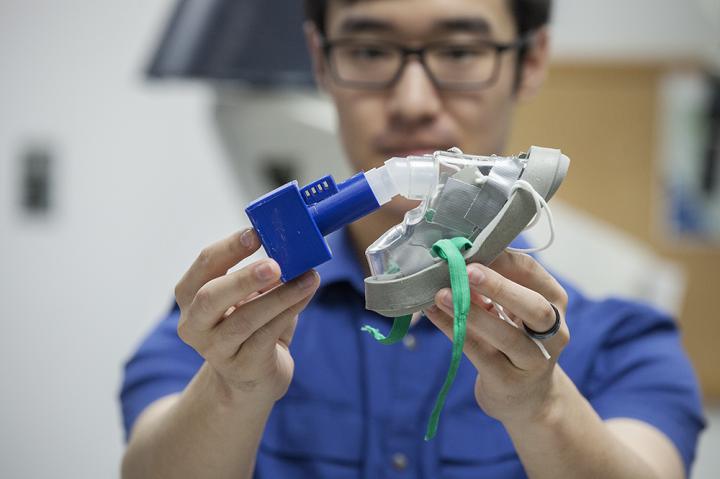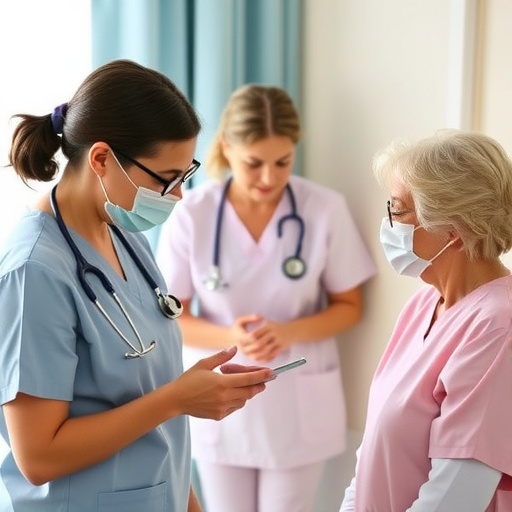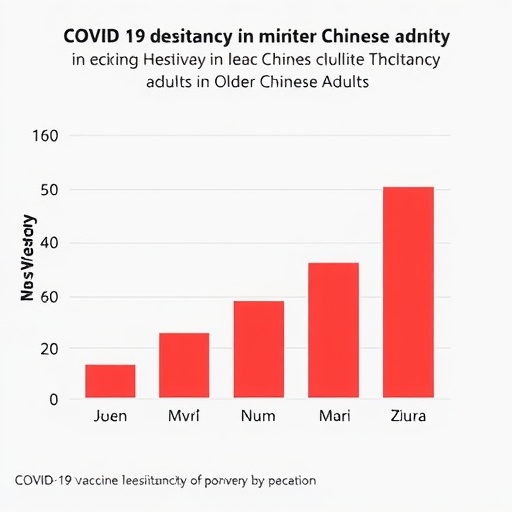The team has been in contact with the US Food and Drug Administration to obtain emergency approval of the device and is talking to manufacturers to see if the design can be mass produced

Credit: Sarah Pack, Medical University of South Carolina
With the threat of a shortage of protective masks looming as the novel coronavirus pandemic grows, Medical University of South Carolina (MUSC) biomedical engineers and tinkerers had an inspired idea: unleash an army of makers from across the U.S. who could make such masks from 3D printers – a technology that, in recent years, has become widely available.
“High schools have a printer capable of making this,” said Michael Yost, Ph.D., vice chair of research in the Department of Surgery. “Let’s make this so simple that a high schooler could do it, yet effective to protect our people.”
In a matter of days, a team came together and developed the Self-Assembly Filter for Emergencies, or SAFE, Cartridge System. The system could be used by medical professionals or by people who just need to go to the grocery store.
The team has been in contact with the U.S. Food and Drug Administration to obtain emergency approval of the device. For now, the device remains investigational and should not be used as a replacement for conventional and approved Personal Protective Equipment.
Yost said the team is talking to manufacturers to see if the design can be mass produced once it has received approval.
The N95 masks that are currently in such short supply are essentially filters molded into mask form. Recreating those masks exactly proved too difficult. So instead, the team created a two-part solution: a 3D printed mask that can be cleaned and reused that will work in tandem with a 3D printed disposable filter cartridge. Alternatively, the filter cartridge could be used with an adapted hospital mask.
Joshua Kim, senior designer and program coordinator in the Department of Surgery Human-Centered Design Program, said he was inspired by the NASA engineers during the Apollo 13 disaster, who quickly devised a makeshift carbon dioxide removal system from materials on hand inside the lunar module, including duct tape and plastic.
“How can we utilize materials that people can get at a local hardware store and repurpose those materials to make protective equipment?” he asked.
The “95” in N95 means these masks filter 95% of particulates of a certain size, he explained. HEPA filters, like those used in air purifiers, filter around 99% of particulates. So he bought a HEPA filter and set about experimenting. Using the same testing that’s used on N95 masks, he found that using those filters in the homemade cartridge did work – a positive sign that they were on the right track.
Meanwhile, another group was working on creating the masks. Dentists Walter Renne, D.M.D., and Christian Brenes Vega, D.D.S., regularly use 3D printing. “It’s just a part of the job,” said Renne, who estimated that 20% of dentists and 90% of dental labs have a 3D printer on hand. They enlisted the help of John Yost, a student and independent contractor who serves as a resource for all things associated with 3D printing on campus.
A team at MUSC developed a DIY protective mask that anyone with a 3D printer can copy.
Initially, they developed different prototypes that would work with different types of filters, including filters used by painters or people dealing with asbestos. They 3D scanned a mask to get the basic shape, then designed modifications so the mask could accommodate the disposable filter cartridge. The filter, noted Brenes Vega, is the most important part. Unfortunately, some people have turned to masks that aren’t actually offering protection, he said.
Finally, they needed to solve the problem of releasing air pressure, Kim said. The filters are so effective that when the wearer exhales, the air will go to the area of least resistance to escape – in other words, not through the filter again but by causing the mask to lift slightly off the wearer’s face. That exposes the wearer to the outside air and renders the mask worthless, Renne said. In response, the team installed a rubber valve, commonly used in other medical applications, that allows the exhaled air to escape the mask. As soon as the wearer inhales, the valve immediately shuts, Kim said, protecting the wearer.
Kim said that, for additional sealing and comfort, they added strips of neoprene weatherstripping foam around the edges of the mask. The foam provides a comfortable fit so the wearer’s skin isn’t touching the plastic mask and ensures it contours to the face as the wearer moves or talks.
With all the parts in place – the 3D printed mask and 3D printed cartridge fitted with a hand-cut HEPA filter and rubber valve – the group began fit-testing.
They took four prototypes to the Emergency Department and tested them on several users. So far, the masks have fit everyone, Yost said, although they want to expand their testing to include more face sizes and shapes.
The team is already printing masks at MUSC, even as they continue to perfect the design.
The biggest obstacle now is the time it takes to create the masks. MUSC’s 3D printers aren’t production-level printers. They’re meant for creating prototypes when time isn’t of the essence. It takes about four to five hours to print a mask and then about an hour to assemble everything.
Because of that time element, Yost is talking to manufacturers who could produce these in greater numbers. But the team is also openly releasing the plans so that anyone with a 3D printer can produce the masks.
In addition to creating the entire mask, makers could create just the disposable cartridge, which can be adapted to fit into the masks used in anesthesiology to deliver oxygen to patients.
###
Legal Disclaimer: Use at Your Own Risk. These technologies should NOT be used as replacements for conventional and approved Personal Protective Equipment (“PPE”). All technologies highlighted on this page were created as exploratory studies conducted at the Medical University of South Carolina in an effort to further protect the safety, health and well-being of our care team members and patients in response to the COVID-19 pandemic. Unless otherwise noted, these technologies have not been industry tested, have not been NIOSH approved, have not been otherwise certified to provide any level of personal protection, and have not been FDA cleared. Full legal disclaimer available at https:/
About the Medical University of South Carolina
Founded in 1824 in Charleston, the Medical University of South Carolina (MUSC) is the oldest medical school in the South, as well as the state’s only integrated, academic health sciences center with a unique charge to serve the state through education, research and patient care. Each year, MUSC educates and trains more than 3,000 students and 700 residents in six colleges: Dental Medicine, Graduate Studies, Health Professions, Medicine, Nursing and Pharmacy. The state’s leader in obtaining biomedical research funds, in fiscal year 2018, MUSC set a new high, bringing in more than $276.5 million. For information on academic programs, visit http://musc.
As the clinical health system of the Medical University of South Carolina, MUSC Health is dedicated to delivering the highest quality patient care available, while training generations of competent, compassionate health care providers to serve the people of South Carolina and beyond. Comprising some 1,600 beds, more than 100 outreach sites, the MUSC College of Medicine, the physicians’ practice plan, and nearly 275 telehealth locations, MUSC Health owns and operates eight hospitals situated in Charleston, Chester, Florence, Lancaster and Marion counties. In 2019, for the fifth consecutive year, U.S. News & World Report named MUSC Health the number one hospital in South Carolina. To learn more about clinical patient services, visit http://muschealth.
MUSC and its affiliates have collective annual budgets of $3 billion. The more than 17,000 MUSC team members include world-class faculty, physicians, specialty providers and scientists who deliver groundbreaking education, research, technology and patient care.
Media Contact
Heather Woolwine
[email protected]
843-792-7669
Original Source
https:/




